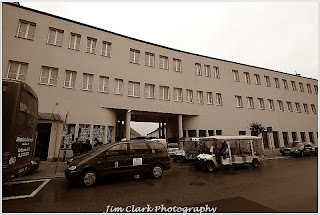Oskar Schindler
Though officially a citizen of Czechoslovakia, Schindler became a spy for German Military Intelligence. He was convicted of espionage and imprisoned by the Czech government in July 1938, he was later released as a political prisoner. In 1939 Schindler joined the Nazi Party.
Schindler Factory Museum
As an opportunistic businessman, Schindler was one of many who sought to profit from the German invasion of Poland in 1939. He gained ownership of an idle enamelware factory in Krakow, which he renamed Deutsche Emaillewaren-Fabrik (DEF). With the help of his German-speaking Jewish accountant Itzhak Stern, Schindler obtained around 1,000 Jewish forced labourers to work there.
In 2010, the Schindler Factory opened as a museum.
Schindlers' Factory today.
Schindler soon adapted his lifestyle to his income. He became a well-respected guest at Nazi SS elite parties, having easy chats with high-ranking SS officers, often for his own benefit. Initially Schindler may have been motivated by money, Jewish labour cost less, but later he began shielding his workers without regard for cost. He would, for instance, claim that certain unskilled workers were essential to the factory.
Enamel ware at the museum
It was whilst witnessing a raid on the Krakow Ghetto in 1943, where soldiers were rounding up inhabitants for shipment to the concentration camp at Plaszow, that Schindler was appalled by the murder of many of the Jews who had been working for him. He was a very persuasive individual, and after the raid, he increasingly used all of his skills to protect his Schindlerjuden ("Schindler's Jews"), as they came to be called.
The special status of his factory (business essential to the war effort) became the decisive factor for Schindler's efforts to support his Jewish workers. Whenever "Schindler Jews" were threatened with deportation, he claimed exemptions for them. Wives, children, and even handicapped persons were shown to be necessary mechanics and metalworkers.
Schindler was arrested three times on suspicion of black market activities and complicity in embezzlement, as well as breaking the Nuremberg Laws by kissing a Jewish girl.
Amon Goth, the commandant of the Płaszów camp, and other SS guards used Jewish property (such as money, jewellery, and works of art) for themselves, although according to law, it belonged to the Reich. Schindler arranged the sale of such items on the black market. None of his arrests led to a trial, primarily because he bribed government officials to avoid further investigation.
As the Red Army drew nearer to Auschwitz concentration camp. Amon Göth's personal secretary, Mietek Pemper alerted Schindler to the Nazis' plans to close all factories not directly involved with the war effort, including Schindler's enamelware facility. Schindler was also encouraged to switch production from enamelware to anti-tank grenades in an effort to save Schindler's Jewish workers.
Tipped off to the factory closure, Schindler persuaded the SS officials to allow him to move his 1,200 Jewish workers to Brunnlitz, thus sparing them from certain death in the gas chambers. Mietek Pemper further aided Schindler's efforts by compiling and typing the list of 1,200 Jews - 1,000 of Schindler's workers and 200 other inmates - who were sent to Brünnlitz in October 1944. Schindlers' List
Schindlers' office
After the war Schindler and his wife Emilie fled to Austria, escaping prosecution by dressing in prison clothes and carrying a letter testifying to their heroic actions. By the end of the war, Schindler had spent his entire fortune on bribes and black-market purchases of supplies for his workers. Virtually destitute, he did not prosper in postwar Germany.
In fact, he was reduced to receiving assistance from Jewish organizations. Eventually, Schindler immigrated to Argentina in 1948, where he went bankrupt. He left his wife Emilie in 1957 and returned to Germany in 1958, where he had a series of unsuccessful business ventures. Schindler settled down in a small apartment in Frankfurt and tried again – with help from a Jewish organization – to establish a cement factory.
This too, went bankrupt in 1961.
Schindler died on 9 October 1974, at the age of 66. He died penniless.
Schindler's grave is located on the mountainside below Zion Gate and the Old City walls. Stones placed on top of the grave are a sign of gratitude from Jewish visitors, according to Jewish tradition, although Schindler himself was not Jewish.
On his grave, the Hebrew inscription reads: "Righteous among the Nations", an honor used by the State of Israel to describe non-Jews who risked their lives during the Holocaust to save Jews from extermination by the Nazis. The German inscription reads: "The Unforgettable Lifesaver of 1200 Persecuted Jews"
No one knows what Schindler's motives were. He was quoted as saying "I knew the people who worked for me... When you know people, you have to behave towards them like human beings."
Schindlers' Factory










0 comments:
Post a Comment